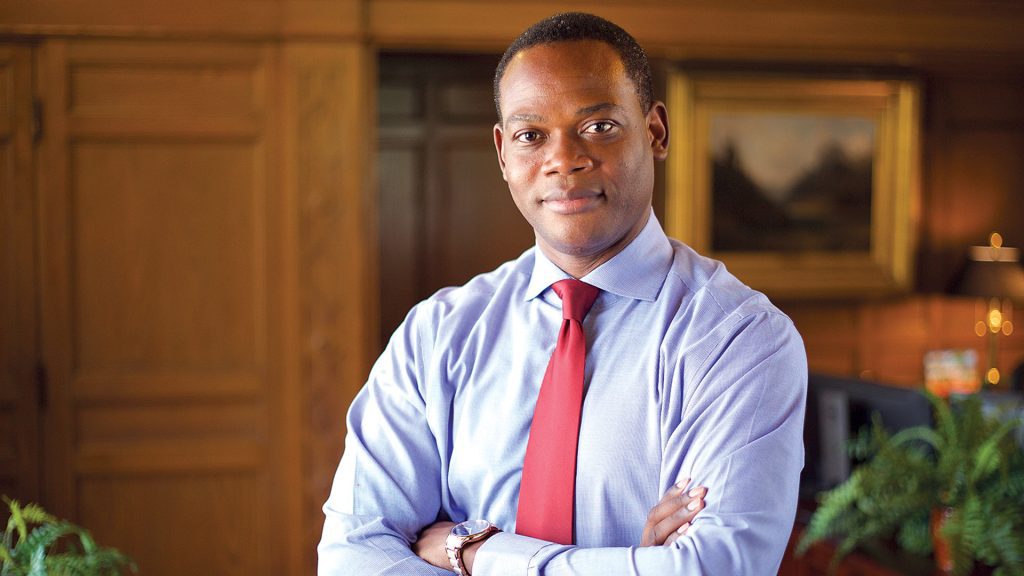Outlook 2022/Higher Education
Region’s Colleges, Universities Face More Stern Tests in 2022
Looking ahead to 2022, Sandra Doran projects that this will be what she called “the year of the woman.”
Elaborating, she said many women have put their lives, careers, and educational goals on hold the past few years. And she projects that many will be making up for lost time in the months to come as the region and its large and important higher-education sector look to return to something that has been quite elusive since March 2020: normalcy.
“COVID has had a disproportionate impact on women, both in the workforce and in higher education,” said Doran, president of Bay Path University in Longmeadow, a women’s college, at least at the undergraduate level. “Many people lost their jobs, and many students weren’t able to continue, especially our adult students, those who work and live and go to school, and our graduate students — many of them had to delay their own aspirations. And I see many people saying, ‘I’m not going to put that aside any longer.’”

Sandra Doran
“Many people lost their jobs, and many students weren’t able to continue, especially our adult students, those who work and live and go to school, and our graduate students — many of them had to delay their own aspirations. And I see many people saying, ‘I’m not going to put that aside any longer.’”
The area’s colleges certainly need this to be the year of the woman — and a better year all around. Many had been struggling with enrollment before the pandemic, due to smaller high-school graduating classes, but other factors as well. And the pandemic only exacerbated the problem, with enrollment down more than 3% nationally in the fall of 2021.
The region’s community colleges have been the hardest-hit, with double-digit drops in enrollment at all of them over the past two years, but all schools have been impacted by COVID.
“Like every state university in Massachusetts, we’re having enrollment challenges,” said Linda Thompson, who took the helm at Westfield State University last summer, noting that many are still wary about attending college in the midst of a pandemic.
Those we spoke with said ‘normal’ was something they were anticipating would return last fall. Indeed, as COVID cases plummeted over the summer and the economy reopened across the board, there were high expectations for that fall semester, said Harry Dumay, president of Elms College in Chicopee. But the Delta variant showed how quickly the picture, and expectations, can change.
And as the new year dawns, COVID and its Omicron variant loom large over this sector, with some uncertainty about whether schools can open their campuses for the spring semester (several closed their doors as Omicron cases spiked in the middle of December) and under what circumstances they can reopen.
“Fall of 2021 was actually a very good enrollment period for us.”
“We’ll be watching over the break to see how things develop, and we will have contingency plans in place if we need to do anything different,” said Dumay, adding that returning students must be vaccinated and receive their boosters as soon as they are eligible. “We’ll be as cautious and prudent as we were in the fall of 2021, and even more so, given what we’ve seen from Omicron.”
There are other challenges as well, especially a workforce crisis that hasn’t spared any sector, especially higher education.
“We have jobs that are going unfilled; we have jobs where, in the past, we’d have 100 applicants — we’re just not seeing that anymore,” said Thompson, noting this trend involves positions at every level and shows few if any signs of abating any time soon.
But amid the questions, concern, and uncertainty, there is also optimism, expressed by Dumay and others, that 2022, and especially the fall semester, will bring improvement on enrollment numbers and a return to something approaching normal.

Harry Dumay says he’s confident about the way enrollment is trending at the Elms heading into 2022.
Or continued improvement, as the case may be.
“Fall of 2021 was actually a very good enrollment period for us,” said Dumay, adding that, after a slight decline in the fall of 2020, the first semester after COVID made its arrival, the school — bucking those national trends — saw record applications among traditional, first-time freshmen, close to record acceptances, and one of the highest enrollment numbers for first-time freshmen in more than a decade.
Meanwhile, the numbers for transfer students and graduate students were also solid, with the latter helped by the opening of a graduate admissions office, he went on, adding that the only segment that was down was continuing education, the students who transfer from community colleges, a statistic in keeping with the struggles at those schools.
“As we look to the fall of 2022, everything is trending as it was in the fall of 2021,” he went on. “In fact, we’re ahead, year over year, in terms of applications, and all three segments that were good last year continue to look very solid for 2022.”
Doran shared that optimism. “I feel very confident about next fall,” she said. “Many students had an online experience over the past few years in high school, and now, they’re looking for a more personalized, in-person fall experience, and that’s what we’re really good at.
“I really see this as a very strong year for women in education and women in the workforce,” she went on. “And I feel that way for several reasons, starting with the fact that I hear women say, ‘we can no longer put on our lives on hold — we have to move forward aggressively, and part of our life plan is to make sure we have the right education.’
“But we also hear from employers that they’re very eager to fill their talent pipeline,” she went on. “They know our students, that they’re well-qualified and exceptional employees, and we’re working very closely with employers to make sure our curriculum provides our students with the strengths, capabilities, skillsets, and thinking ability to succeed; I see it on both sides of the equation.”
Linda Thompson
“We’re looking at more things we can do with community colleges. We need to streamline pathways from high school to community college to four-year institutions. These are the things that are going to much more prevalent moving forward.”
When asked if the phrase ‘pent-up demand,’ which is being heard in many contexts as the economy continues to grow, also pertains to higher education, those we spoke with offered a qualified ‘yes,’ noting that there is demand for education that is career-focused.
“I think we’re going to see increased enrollment in the online space, and I think it’s because women know that, to advance their careers and to realize their career aspirations, many of them need a credential, a bachelor’s degree, a master’s degree — if you’re going to teach in Massachusetts, eventually you’ll need a master’s degree,” Doran said. “There’s a lot of momentum around educational attainment, particularly for our students. That’s because we’re really focused on student services, internship, career development, and making sure our curriculum aligns with workforce needs.”
Thompson agreed, noting that, as the number of high-school graduates continues to decline, colleges and universities need to increase their focus on those who may have tried college and stopped because life got in the way.
“Now, they’re probably looking for opportunities for growth and moving up in their jobs,” she noted. “So we need to do more to reach adult populations; faculty are starting to look at the way they offer courses, and probably will be offering more things in a blended format.
“Also, we’re looking at more things we can do with community colleges,” she went on. “We need to streamline pathways from high school to community college to four-year institutions. These are the things that are going to much more prevalent moving forward.”
Beyond enrollment and a long list or protocols to be followed and updated as necessary, COVID has brought other challenges as well, and these will certainly continue in 2022, said those we spoke with. Dumay told BusinessWest that managing through the pandemic has been difficult and exhausting on many levels.
“Across higher education, and across all industries, for that matter, people are tired,” he said. “If you ask any college president, they would say they and their teams are … fill in your favorite word — they’re on edge, they’re tired, they’re demoralized. And we’re paying attention to all that.”
Elaborating, he said ‘all that’ means paying more attention to the needs of students, obviously, but also faculty and staff, many of whom are coping with pandemic-related issues off the job as well as on it, and also focusing on the mental health of students.
“Students have different ways of coping with the uncertainty of the time,” he said. “And we’re seeing, across all campuses, a lot more students with mental-health issues, and COVID is exacerbating that.
“All of these things have created a whole lot of challenges, and there’s been very little let-up,” Dumay said in conclusion, adding that this trend, in addition to all the others, will almost certainly continue into the new year.”
Thompson agreed. “I think we’re going to be living with this virus for a long time,” she said. “I see it continuing to mutate; I see us having to be vigilant with hand washing, wearing masks, paying attention to our health and well-being, and doing whatever we need to do.”
— George O’Brien






